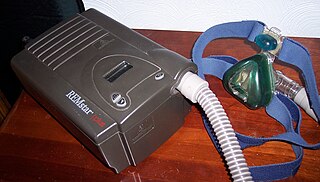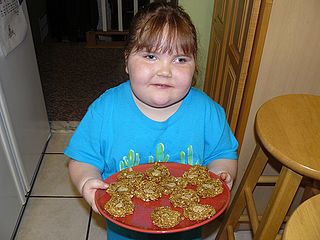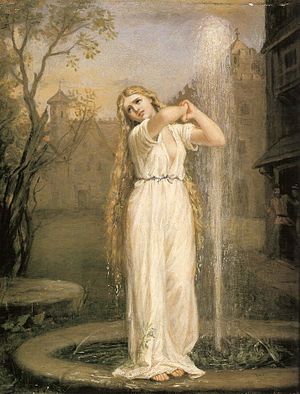
Sleep apnea, also spelled sleep apnoea, is a sleep disorder in which pauses in breathing or periods of shallow breathing during sleep occur more often than normal. Each pause can last for a few seconds to a few minutes and they happen many times a night. In the most common form, this follows loud snoring. A choking or snorting sound may occur as breathing resumes. Because the disorder disrupts normal sleep, those affected may experience sleepiness or feel tired during the day. In children, it may cause hyperactivity or problems in school.

Locked-in syndrome (LIS), also known as pseudocoma, is a condition in which a patient is aware but cannot move or communicate verbally due to complete paralysis of nearly all voluntary muscles in the body except for vertical eye movements and blinking. The individual is conscious and sufficiently intact cognitively to be able to communicate with eye movements. Electroencephalography results are normal in locked-in syndrome. Total locked-in syndrome, or completely locked-in state (CLIS), is a version of locked-in syndrome wherein the eyes are paralyzed as well. Fred Plum and Jerome B. Posner coined the term for this disorder in 1966.

Chiari malformation (CM) is a structural defect in the cerebellum, characterized by a downward displacement of one or both cerebellar tonsils through the foramen magnum. CMs can cause headaches, difficulty swallowing, vomiting, dizziness, neck pain, unsteady gait, poor hand coordination, numbness and tingling of the hands and feet, and speech problems. Less often, people may experience ringing or buzzing in the ears, weakness, slow heart rhythm, or fast heart rhythm, curvature of the spine (scoliosis) related to spinal cord impairment, abnormal breathing, such as central sleep apnea, characterized by periods of breathing cessation during sleep, and, in severe cases, paralysis.

Obesity hypoventilation syndrome (OHS) is a condition in which severely overweight people fail to breathe rapidly or deeply enough, resulting in low oxygen levels and high blood carbon dioxide (CO2) levels. The syndrome is often associated with obstructive sleep apnea (OSA), which causes periods of absent or reduced breathing in sleep, resulting in many partial awakenings during the night and sleepiness during the day. The disease puts strain on the heart, which may lead to heart failure and leg swelling.
Hypoventilation occurs when ventilation is inadequate to perform needed respiratory gas exchange. By definition it causes an increased concentration of carbon dioxide (hypercapnia) and respiratory acidosis. Hypoventilation is not synonymous with respiratory arrest, in which breathing ceases entirely and death occurs within minutes due to hypoxia and leads rapidly into complete anoxia, although both are medical emergencies. Hypoventilation can be considered a precursor to hypoxia and its lethality is attributed to hypoxia with carbon dioxide toxicity.

Obstructive sleep apnea (OSA) is the most common sleep-related breathing disorder and is characterized by recurrent episodes of complete or partial obstruction of the upper airway leading to reduced or absent breathing during sleep. These episodes are termed "apneas" with complete or near-complete cessation of breathing, or "hypopneas" when the reduction in breathing is partial. In either case, a fall in blood oxygen saturation, a disruption in sleep, or both, may result. A high frequency of apneas or hypopneas during sleep may interfere with the quality of sleep, which – in combination with disturbances in blood oxygenation – is thought to contribute to negative consequences to health and quality of life. The terms obstructive sleep apnea syndrome (OSAS) or obstructive sleep apnea–hypopnea syndrome (OSAHS) may be used to refer to OSA when it is associated with symptoms during the daytime.

Hypoxemia is an abnormally low level of oxygen in the blood. More specifically, it is oxygen deficiency in arterial blood. Hypoxemia has many causes, and often causes hypoxia as the blood is not supplying enough oxygen to the tissues of the body.
Hypopnea is overly shallow breathing or an abnormally low respiratory rate. Hypopnea is defined by some to be less severe than apnea, while other researchers have discovered hypopnea to have a "similar if not indistinguishable impact" on the negative outcomes of sleep breathing disorders. In sleep clinics, obstructive sleep apnea syndrome or obstructive sleep apnea–hypopnea syndrome is normally diagnosed based on the frequent presence of apneas and/or hypopneas rather than differentiating between the two phenomena. Hypopnea is typically defined by a decreased amount of air movement into the lungs and can cause oxygen levels in the blood to drop. It commonly is due to partial obstruction of the upper airway.

Paired-like homeobox 2b (PHOX2B), also known as neuroblastoma Phox (NBPhox), is a protein that in humans is encoded by the PHOX2B gene located on chromosome 4.
The International Classification of Sleep Disorders (ICSD) is "a primary diagnostic, epidemiological and coding resource for clinicians and researchers in the field of sleep and sleep medicine". The ICSD was produced by the American Academy of Sleep Medicine (AASM) in association with the European Sleep Research Society, the Japanese Society of Sleep Research, and the Latin American Sleep Society. The classification was developed as a revision and update of the Diagnostic Classification of Sleep and Arousal Disorders (DCSAD) that was produced by both the Association of Sleep Disorders Centers (ASDC) and the Association for the Psychophysiological Study of Sleep and was published in the journal Sleep in 1979. A second edition, called ICSD-2, was published by the AASM in 2005. The third edition, ICSD-3, was released by the AASM in 2014. A text revision of the third edition (ICSD-3-TR) was published in 2023 by the AASM.
In human neuroanatomy, brainstem auditory evoked potentials (BAEPs), also called brainstem auditory evoked responses (BAERs), are very small auditory evoked potentials in response to an auditory stimulus, which are recorded by electrodes placed on the scalp. They reflect neuronal activity in the auditory nerve, cochlear nucleus, superior olive, and inferior colliculus of the brainstem. They typically have a response latency of no more than six milliseconds with an amplitude of approximately one microvolt.

Diaphragm pacing is the rhythmic application of electrical impulses to the diaphragm to provide artificial ventilatory support for respiratory failure or sleep apnea. Historically, this has been accomplished through the electrical stimulation of a phrenic nerve by an implanted receiver/electrode, though today an alternative option of attaching percutaneous wires to the diaphragm exists.

Rapid-onset obesity with hypothalamic dysregulation, hypoventilation, and autonomic dysregulation (ROHHAD) is a rare condition whose etiology is currently unknown. ROHHAD mainly affects the endocrine system and autonomic nervous system, but patients can exhibit a variety of signs. Patients present with both alveolar hypoventilation along with hypothalamic dysfunction, which distinguishes ROHHAD from congenital central hypoventilation syndrome (CCHS). ROHHAD is a rare disease, with only 100 reported cases worldwide thus far.
The Lazarus sign or Lazarus reflex is a reflex movement in brain-dead or brainstem failure patients, which causes them to briefly raise their arms and drop them crossed on their chests. The phenomenon is named after the Biblical figure Lazarus of Bethany, whom Jesus raised from the dead according to the Gospel of John.
Central sleep apnea (CSA) or central sleep apnea syndrome (CSAS) is a sleep-related disorder in which the effort to breathe is diminished or absent, typically for 10 to 30 seconds either intermittently or in cycles, and is usually associated with a reduction in blood oxygen saturation. CSA is usually due to an instability in the body's feedback mechanisms that control respiration. Central sleep apnea can also be an indicator of Arnold–Chiari malformation.
Neurocristopathy is a diverse class of pathologies that may arise from defects in the development of tissues containing cells commonly derived from the embryonic neural crest cell lineage. The term was coined by Robert P. Bolande in 1974.
A sleep-related breathing disorder is a sleep disorder in which abnormalities in breathing occur during sleep that may or may not be present while awake. According to the International Classification of Sleep Disorders, sleep-related breathing disorders are classified as follows:
Classification of sleep disorders, as developed in the 19th century, used primarily three categories: insomnia, hypersomnia and nightmare. In the 20th century, increasingly in the last half of it, technological discoveries led to rapid advances in the understanding of sleep and recognition of sleep disorders. Major sleep disorders were defined following the development of electroencephalography (EEG) in 1924 by Hans Berger.
Infantile apnea is a rare disease that is characterized by cessation of breathing in an infant for at least 20 seconds or a shorter respiratory pause that is associated with a slow heart rate, bluish discolouration of the skin, extreme paleness, gagging, choking and/or decreased muscle tone. Infantile apnea occurs in children under the age of one and it is more common in premature infants. Symptoms of infantile apnea occur most frequently during the rapid eye movement (REM) stage of sleep. The nature and severity of breathing problems in patients can be detected in a sleep study called a polysomnography which measures the brain waves, heartbeat, body movements and breathing of a patient overnight. Infantile apnea can be caused by developmental problems that result in an immature brainstem or it can be caused other medical conditions. As children grow and develop, infantile apnea usually does not persist. Infantile apnea may be related to some cases of sudden infant death syndrome (SIDS) however, the relationship between infantile apnea and SIDS is not known.
Anti-Hu associated encephalitis, also known as Anti-ANNA1 associated encephalitis, is an uncommon form of brain inflammation that is associated with an underlying cancer. It can cause psychiatric symptoms such as depression, anxiety, and hallucinations. It can also produce neurological symptoms such as confusion, memory loss, weakness, sensory loss, pain, seizures, and problems coordinating the movement of the body.








